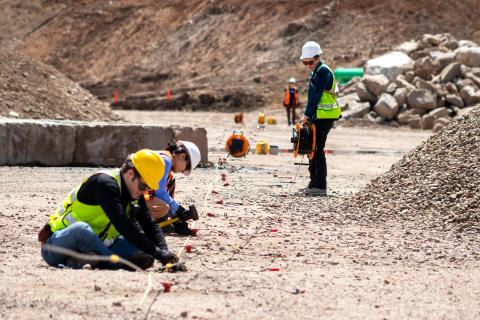All Categories
Featured
Table of Contents
Geophysical Survey And Investigations in Duncraig Aus 2021

The main design for the radial structure of the interior of the Earth is the preliminary recommendation Earth design (PREM). Some parts of this design have been upgraded by recent findings in mineral physics (see post-perovskite) and supplemented by seismic tomography. The mantle is mainly composed of silicates, and the limits in between layers of the mantle follow stage transitions.

Schematic of Earth's magnetosphere. Flows from left to.
Inside the magnetosphere, there are fairly dense regions of solar wind particles called the Van Allen radiation belts. Geophysical measurements are usually at a particular time and place.
Job Profiles : Geophysicist Physics in Redcliffe Western Australia 2020
A three-dimensional position is computed utilizing messages from four or more noticeable satellites and referred to the 1980 Geodetic Recommendation System. An option, optical astronomy, combines huge collaborates and the regional gravity vector to get geodetic collaborates. This method just supplies the position in two collaborates and is harder to utilize than GPS.
Gravity measurements ended up being part of geodesy since they were needed to related measurements at the surface area of the Earth to the reference coordinate system.
Sea level can also be measured by satellites using radar altimetry, adding to a more accurate geoid. In 2002, NASA released the Gravity Recovery and Climate Experiment (GRACE), wherein two twin satellites map variations in Earth's gravity field by making measurements of the range in between the two satellites utilizing GPS and a microwave ranging system. Satellites in space have actually made it possible to gather information from not only the noticeable light area, however in other areas of the electro-magnetic spectrum. The worlds can be characterized by their force fields: gravity and their electromagnetic fields, which are studied through geophysics and area physics. Measuring the modifications in velocity experienced by spacecraft as they orbit has actually enabled great details of the gravity fields of the worlds to be mapped.
Job Profiles : Geophysicist Physics in Henley Brook Australia 2022

Since geophysics is worried with the shape of the Earth, and by extension the mapping of functions around and in the world, geophysical measurements include high accuracy GPS measurements. Once the geophysical measurements have actually been processed and inverted, the translated results are plotted using GIS.
Numerous geophysics business have designed in-house geophysics programs that pre-date Arc, GIS and Geo, Soft in order to meet the visualization requirements of a geophysical dataset. Exploration geophysics is applied geophysics that frequently utilizes remote noticing platforms such as; satellites, airplane, ships, boats, rovers, drones, borehole sensing equipment, and seismic receivers.
For example, aeromagnetic data (airplane collected magnetic data) gathered utilizing standard fixed-wing aircraft platforms must be fixed for electromagnetic eddy currents that are produced as the aircraft moves through Earth's electromagnetic field. There are also corrections connected to modifications in determined possible field intensity as the Earth turns, as the Earth orbits the Sun, and as the moon orbits the Earth.
Become An Earthquake Scientist in Straffon WA 2020
Signal processing includes the correction of time-series data for undesirable noise or errors presented by the measurement platform, such as aircraft vibrations in gravity data. It also includes the reduction of sources of sound, such as diurnal corrections in magnetic information., meteorology, and physics.
The magnetic compass existed in China back as far as the fourth century BC. It was not up until great steel needles could be forged that compasses were utilized for navigation at sea; prior to that, they could not retain their magnetism long enough to be beneficial.
By looking at which of 8 toads had the ball, one might identify the instructions of the earthquake. It was 1571 years before the first style for a seismoscope was released in Europe, by Jean de la Hautefeuille. It was never ever built. Among the publications that marked the beginning of modern-day science was William Gilbert's (1600 ), a report of a series of meticulous experiments in magnetism.
Geophysicist Job Description: Salary, Duties, & More in Ballajura Oz 2021
In 1687 Isaac Newton released his, which not just laid the foundations for classical mechanics and gravitation however also discussed a range of geophysical phenomena such as the tides and the precession of the equinox. The very first seismometer, an instrument efficient in keeping a constant record of seismic activity, was developed by James Forbes in 1844. Dietmar; Sdrolias, Maria; Gaina, Carmen; Roest, Walter R. (April 2008). "Age, spreading rates, and spreading out asymmetry of the world's ocean crust". Geochemistry, Geophysics, Geosystems. 9 (4 ): Q04006. Bibcode:2008 GGG ... 9. 4006M. doi:10. 1029/2007GC001743. S2CID 15960331. "Earth's Inconstant Magnetic Field". science@nasa. National Aeronautics and Area Administration. 29 December 2003. Retrieved 13 November 2018.
Runcorn, S.K, (editor-in-chief), 1967, International dictionary of geophysics:. Pergamon, Oxford, 2 volumes, 1,728 pp., 730 fig Geophysics, 1970, Encyclopaedia Britannica, Vol. Intro to seismology (2nd ed.).
Table of Contents
Latest Posts
Greeley-evans Area 3d Geophysical Survey in Bicton Australia 2022
Airborne Geophysical Methods in Bateman Western Australia 2022
Integrated Geophysical Surveys For The Safety in Beeliar Australia 2021
More
Latest Posts
Greeley-evans Area 3d Geophysical Survey in Bicton Australia 2022
Airborne Geophysical Methods in Bateman Western Australia 2022
Integrated Geophysical Surveys For The Safety in Beeliar Australia 2021